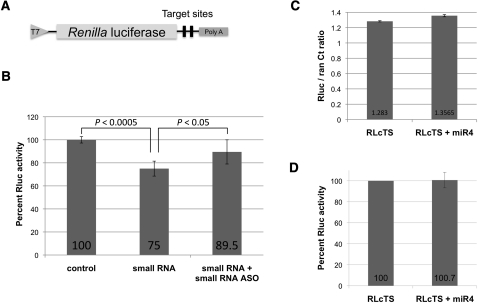FIGURE 2.
The small RNA–mediated repression of RLuc expression. (A) Diagram of the RLuc reporter construct RLcTS containing two copies of the small RNA antisense sequence at the 3′ UTR. (B) Percentage of RLuc activity of Giardia trophozoites transfected with capped in vitro transcript of RLcTS along with or without the synthetic small RNA (1 μg). The presence of the synthetic small RNA resulted in a ∼25% decrease in RLuc activity. This loss could be restored to ∼90% by cotransfecting the cells with a 2′-O methylated small RNA antisense oligo (1 μg). These results represent the average and standard deviations from at least three independent experiments and the Students t-test was used to determine P-values. Comparison of single or double antisense target sites using this assay resulted in a similar outcome (Li et al. 2011). (C) Total RNA from Giardia WB cells transfected with RLcTS mRNA alone or with miR4 was isolated. The RLcTS mRNA level was assayed by real-time PCR with Ran mRNA as a control. The ratios of RLcTS/Ran show little difference between the two samples, suggesting that the inhibition in RLuc expression is not due to mRNA degradation. (D) The presence of miR4 did not affect the expression of RLuc in the GlAgo knockdown cells, suggesting that GlAgo is required for the miR4-mediated inhibition.

